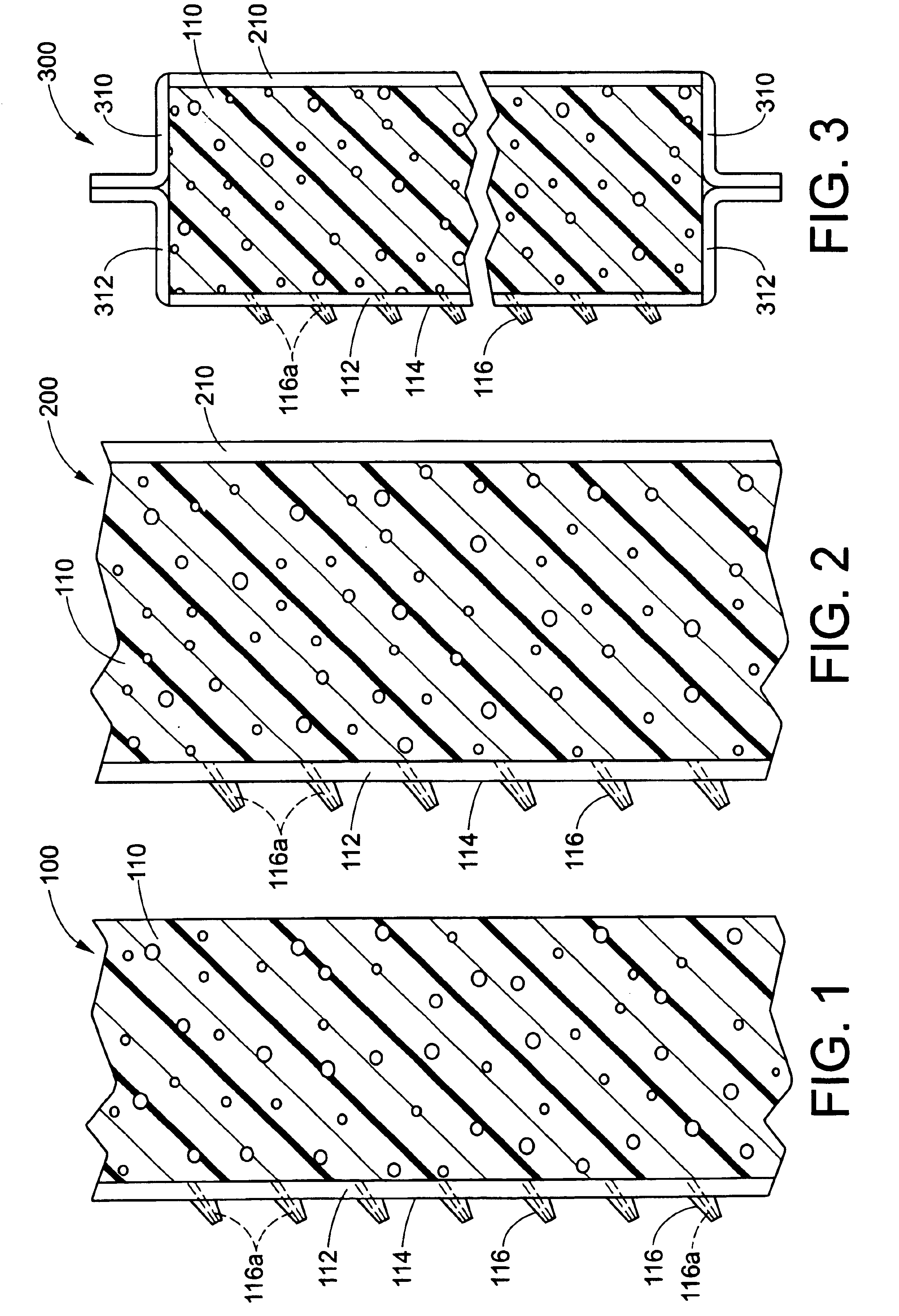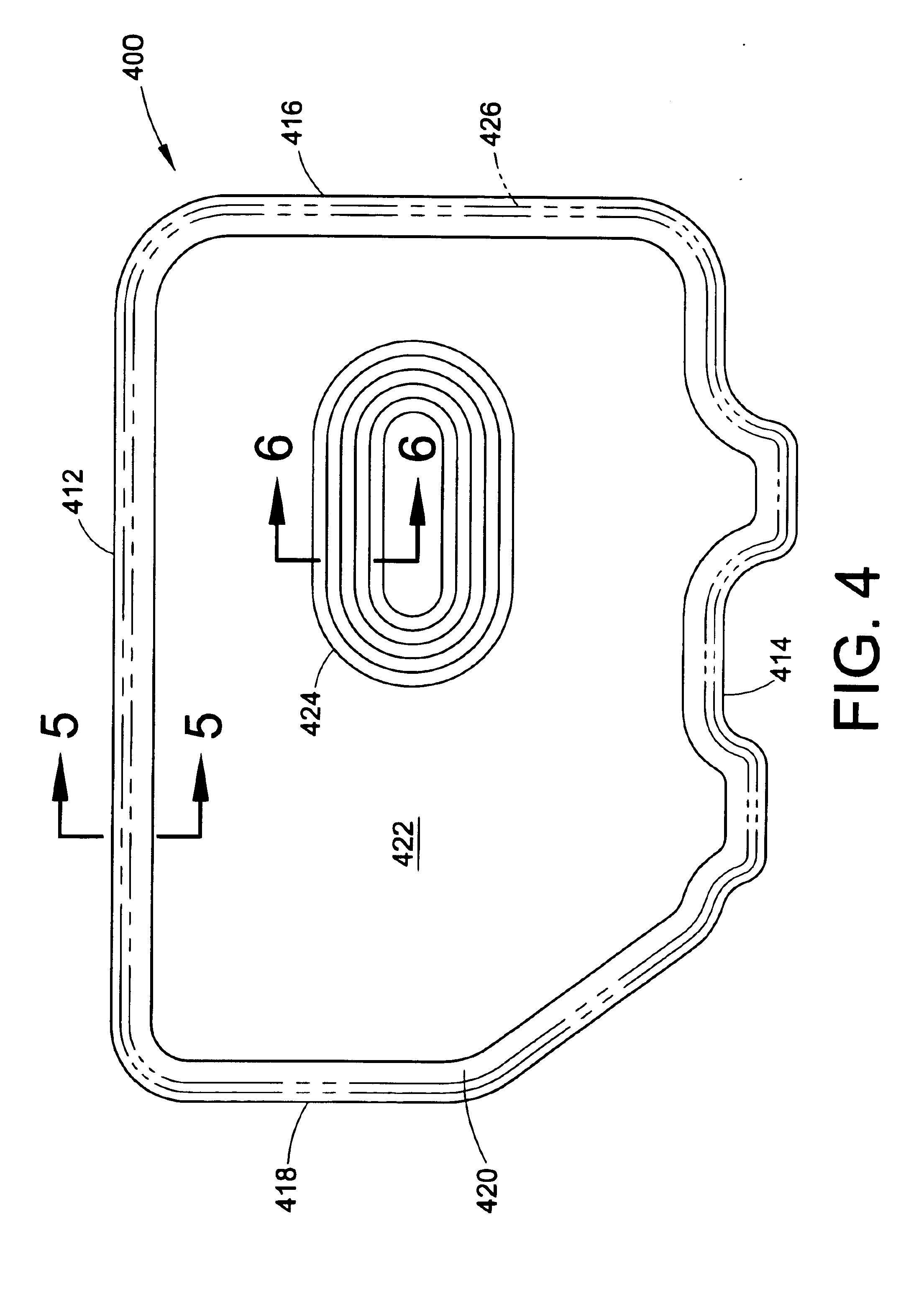Sound-absorbing composites and shield devices employing same
a composite and shielding technology, applied in the field of acoustic composites or laminates, can solve the problems of slow heat and pressure process, inability to significantly contribute in terms of sound insulation qualities, and combination that has typically had significant drawbacks in terms of cost and/or processing difficulties, etc., to achieve effective blocking water and other environmental contaminants, efficient sound passing into the foam, and improved sound absorption
- Summary
- Abstract
- Description
- Claims
- Application Information
AI Technical Summary
Benefits of technology
Problems solved by technology
Method used
Image
Examples
first embodiment
[0025]FIG. 1 illustrates a composite or laminate article 100 formed in accordance with the present invention suitable for use as a sound-absorbing water shield or deflector. The composite 100 includes a porous, energy absorbing foam layer 110 which is protected from water penetration by a film layer 112 that allows acoustic energy to pass while repelling or otherwise blocking the passage of water therethrough.
[0026]The foam layer is preferably a urethane foam, most preferably an ether-type urethane foam. Preferably, the foam has a thickness of at least about 5 mm, preferably about 10 mm. Additionally, although many different types of open- or closed-cell urethane foam could be used, the subject preferred form has a pore size of from about 8-32 cells / cm, preferably about 16 cells / cm, and a density of from about 20 to about 35 kg / m3, preferably about 27 kg / m3. Other acoustic energy absorbing materials include, but are not limited to, other open- or closed-cell polymeric foam materials...
second embodiment
[0031]Referring now to FIG. 2, there is shown a sound-absorbing water shield 200 formed in accordance with the present invention wherein like reference numerals are as described above by way of reference to FIG. 1, and further comprising a continuous, imperforate plastic film layer 210 disposed opposite the perforated film 112 on foam layer 110. The film layer 210, which may be formed of the same or a different material as the perforated film 112, is laminated to foam layer 110, e.g., using an adhesive. Layer 210 can be applied before layer 112, and in such cases, other conventional techniques for bonding the imperforate layer 210 and foam layer 110 can be used, such as flame bonding, heat lamination, and the like. The embodiment of FIG. 2 is advantageous in that the imperforate layer 210, which lacks the acoustic transparency of the perforate film layer 112, further assists in trapping acoustic energy in the core foam material.
third embodiment
[0032]Referring now to FIG. 3, there is shown a sound-absorbing water shield 300 formed in accordance with the present invention wherein like reference numerals are as described above by way of reference to FIGS. 1 and 2, and further including sealed encasing film layers 310 and 312 extending around the perimeter of the article 300. Film layers 310 and 312 can comprise separately formed members or, alternatively, can be integrally formed with film layers 210 and 112, respectively. In this manner, the foam layer 110 is sealed on all sides against water and other contaminants entering therein.
[0033]Referring now to FIGS. 4-6, a sound-absorbing water deflector sheet 400 of the present invention is shown which is particularly intended for use in a vehicle door construction to protect the door trim panel from water, and to also cover and overlie certain door mounted components, such as speakers, window and door electric switch mechanisms, and the like. The peripheral shape of the protect...
PUM
 Login to View More
Login to View More Abstract
Description
Claims
Application Information
 Login to View More
Login to View More - R&D
- Intellectual Property
- Life Sciences
- Materials
- Tech Scout
- Unparalleled Data Quality
- Higher Quality Content
- 60% Fewer Hallucinations
Browse by: Latest US Patents, China's latest patents, Technical Efficacy Thesaurus, Application Domain, Technology Topic, Popular Technical Reports.
© 2025 PatSnap. All rights reserved.Legal|Privacy policy|Modern Slavery Act Transparency Statement|Sitemap|About US| Contact US: help@patsnap.com



